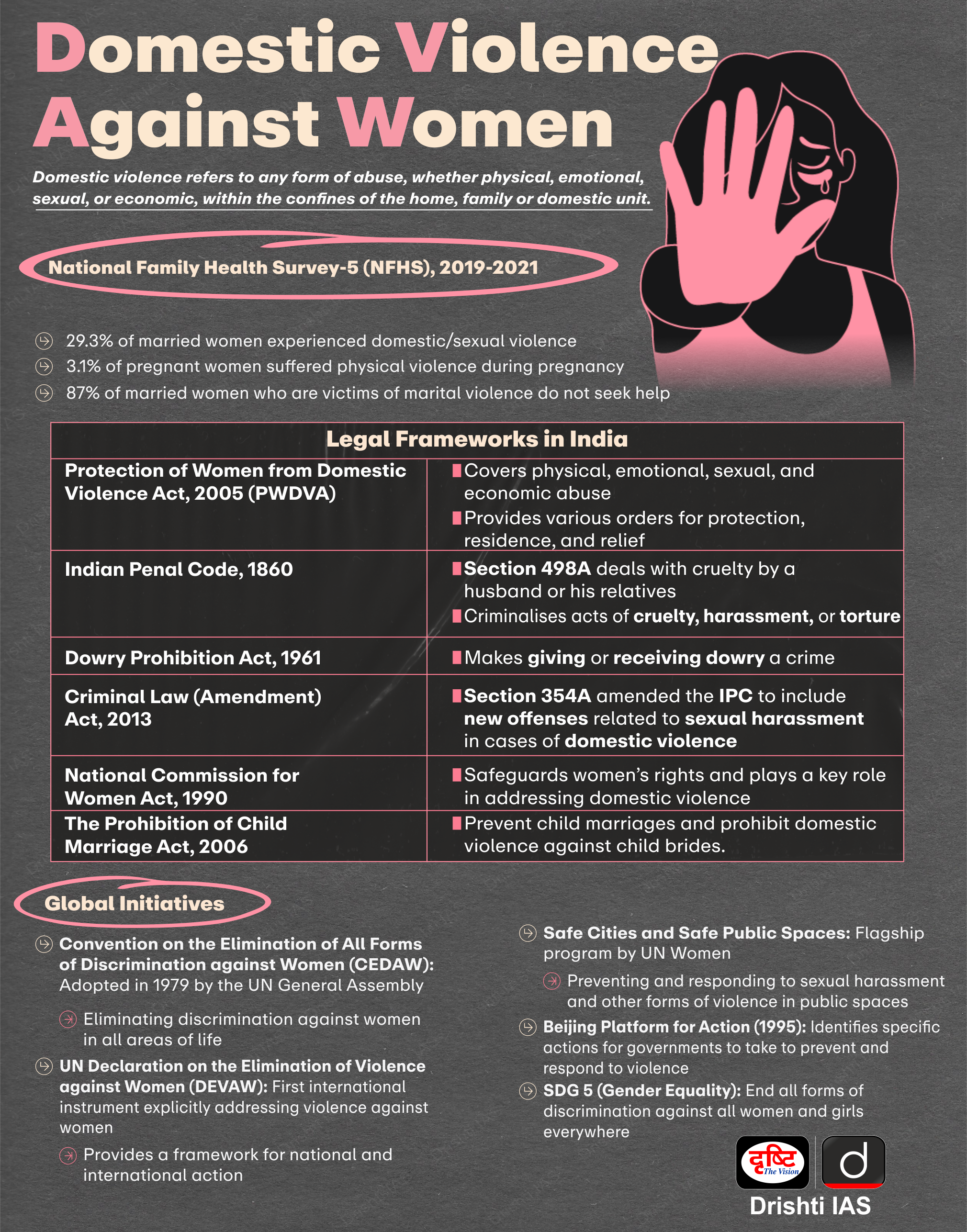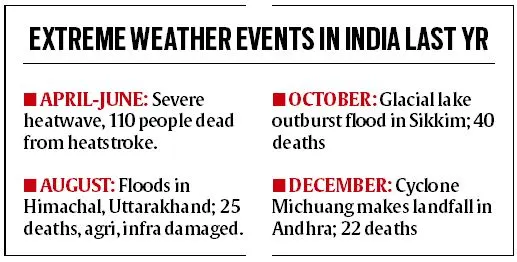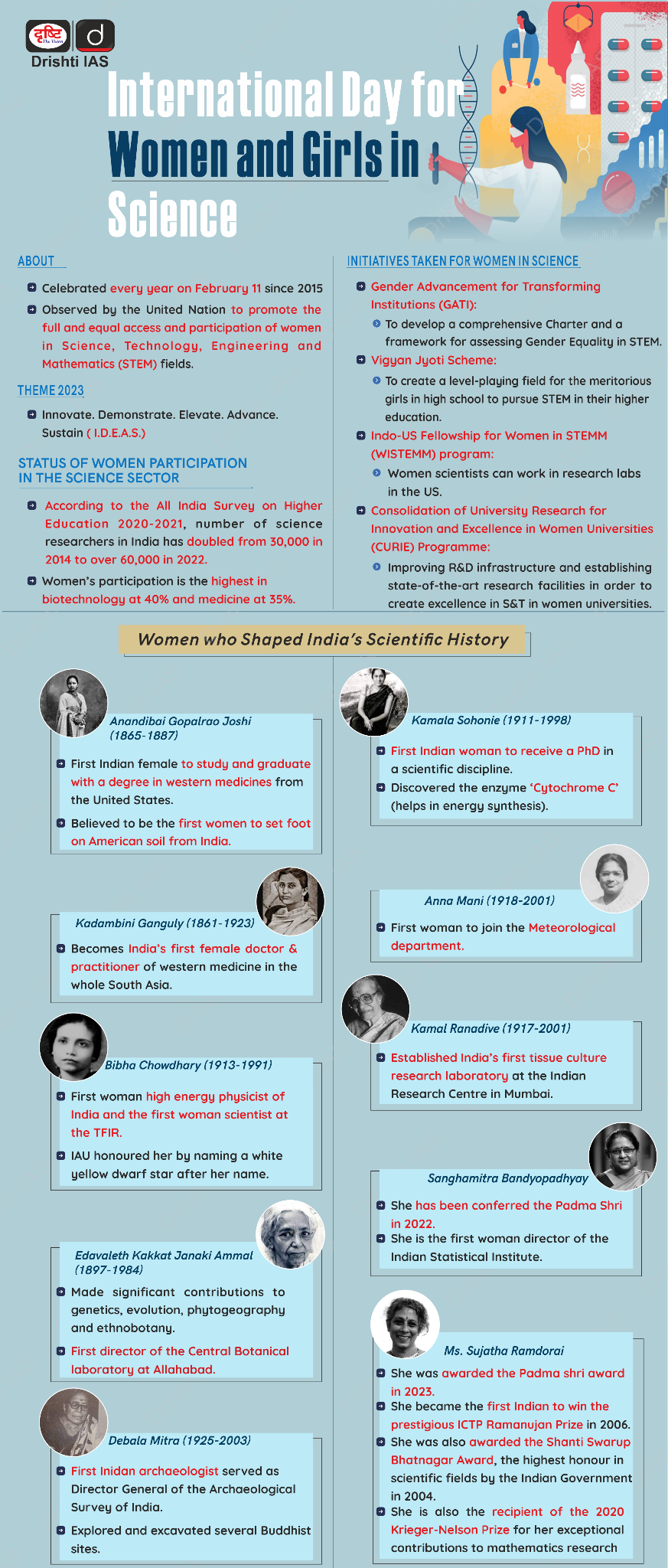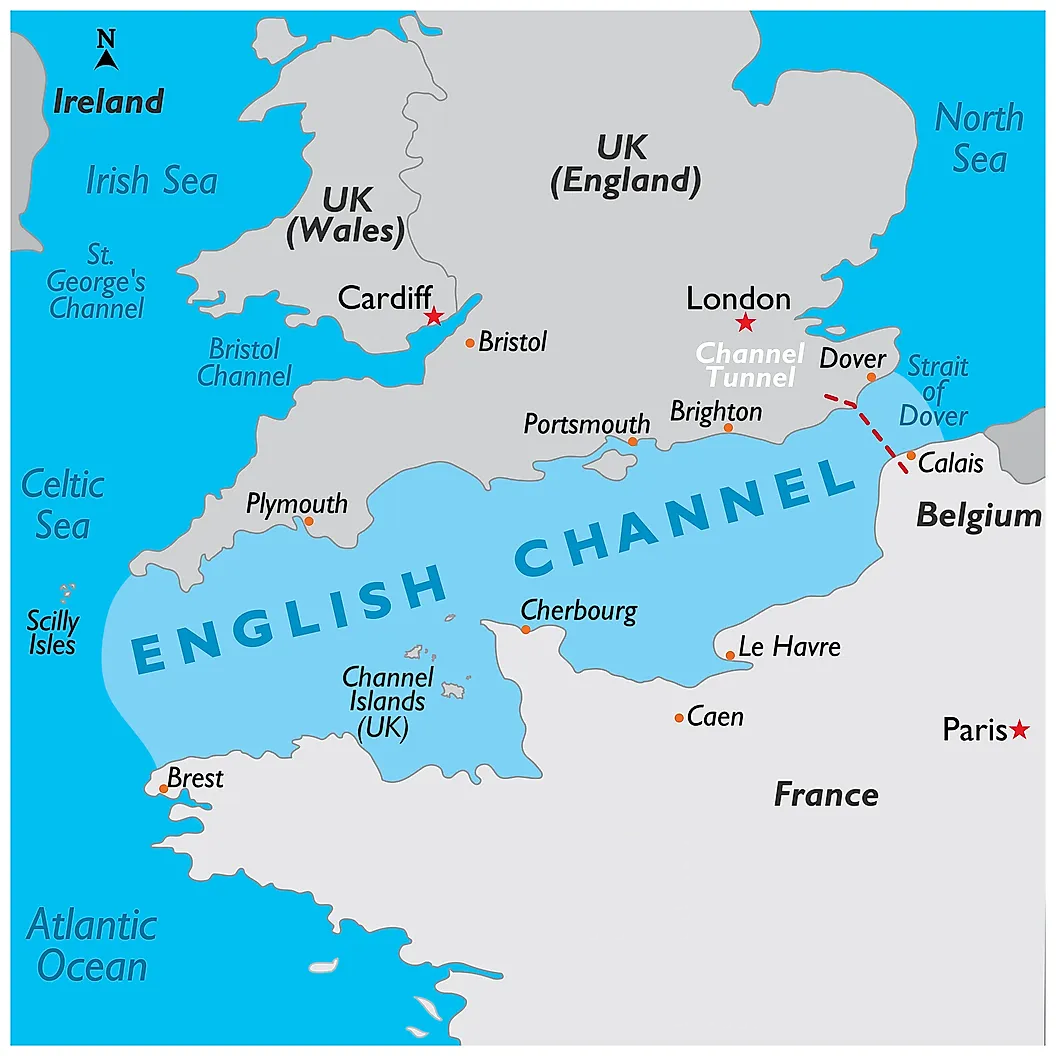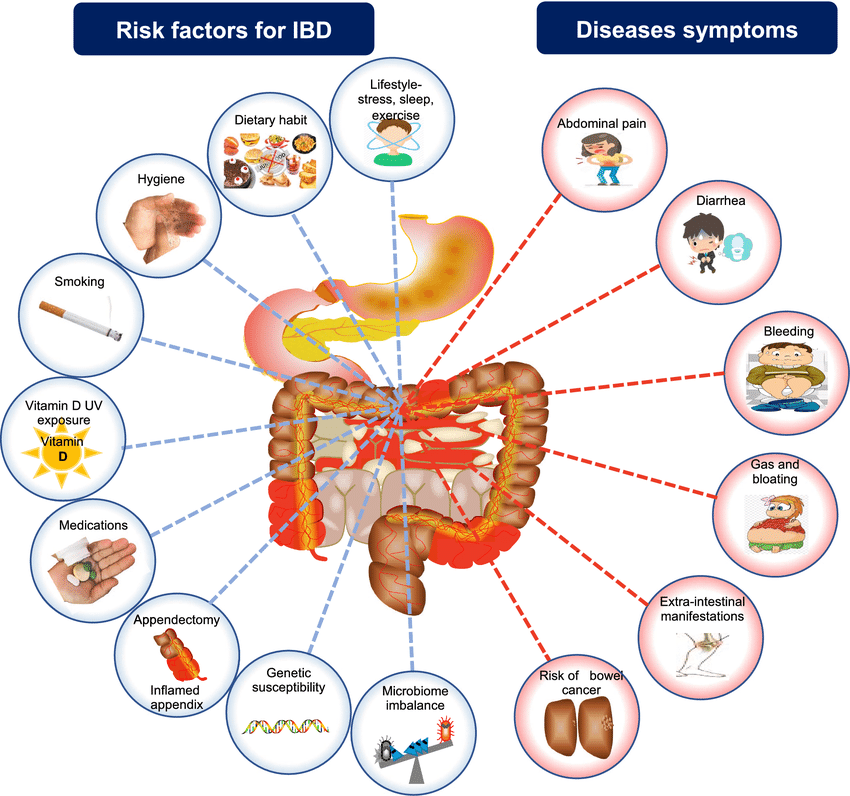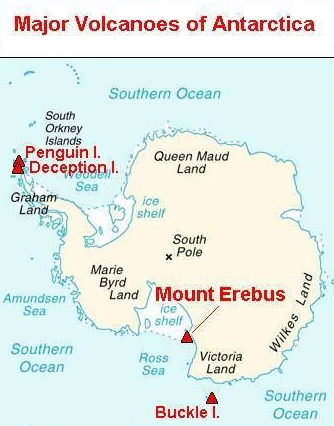Infographics
Domestic Violence Against Women
Read More: Protection of Women from Domestic Violence, Violence Against Women, SC on Crimes and Violence Against Women

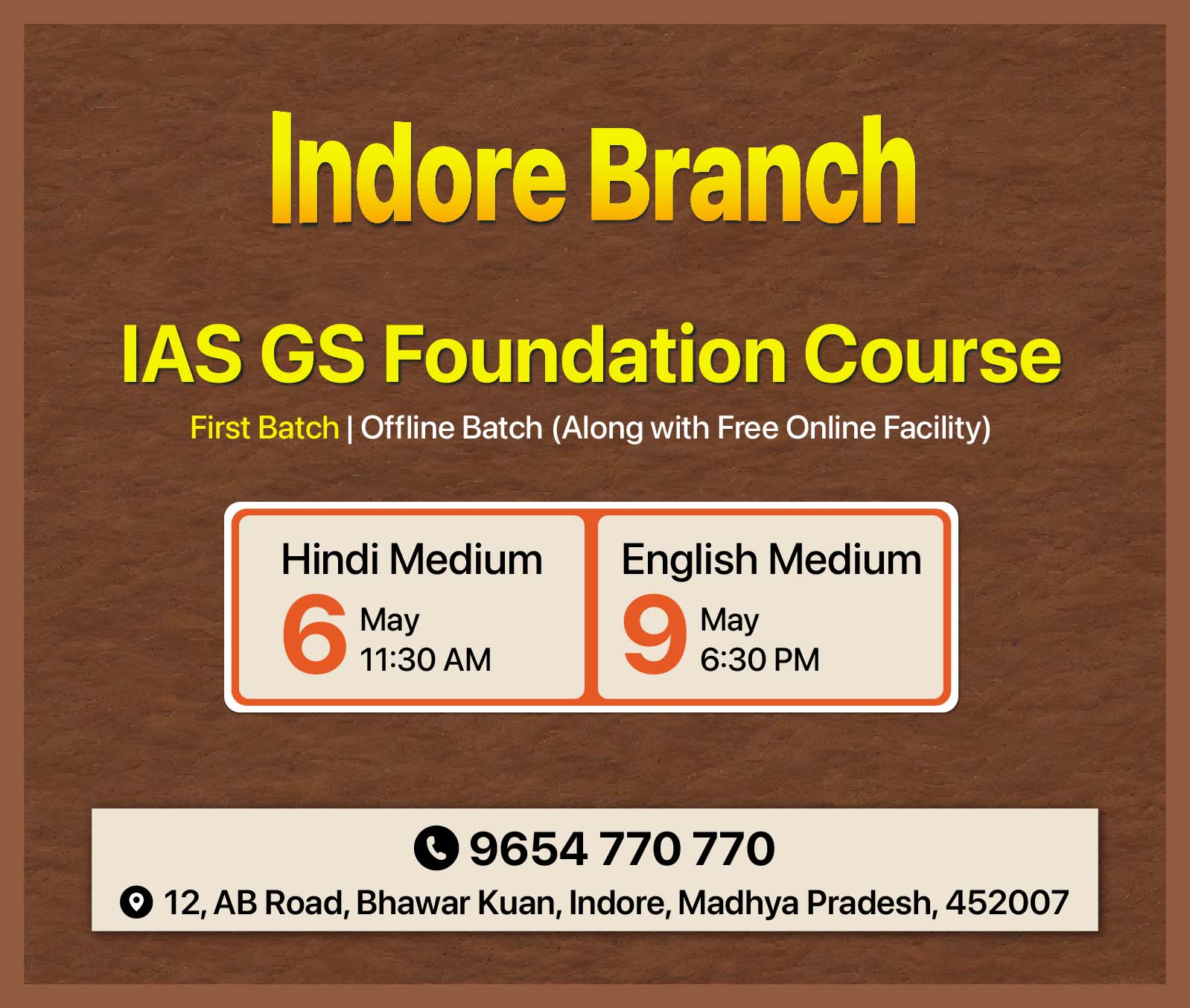
Biodiversity & Environment
The State of the Climate in Asia 2023
For Prelims: World Meteorological Organization, Heatwaves, Glacial lake outbursts, Sundarbans, National Action Plan on Climate Change, National Adaptation Fund on Climate Change
For Mains: Effects of Climate Change, Government initiatives, Conservation
Why in News?
The World Meteorological Organization (WMO) has released a report titled "The State of the Climate in Asia 2023," which sheds light on the alarming impact of climate change.
- The report highlights the severe consequences of extreme weather events, rising temperatures, and environmental changes in the Asian continent.
What are the Key Highlights of the Report?
- Asia as Most Disaster-Prone Region:
- Asia experienced 79 extreme weather events in 2023, affecting over nine million people.
- Over 2,000 deaths were directly attributed to these disasters.
- Floods and storms caused the highest number of casualties and economic losses in Asia in 2023.
- The report noted that Asia has warmed faster than the global average and the warming trend has nearly doubled since the 1961-1990 period.
- The accelerating rate of key climate change indicators such as surface temperatures, glacier retreat and sea level rise will have major consequences for Asia, its economy and ecosystems, the report emphasised.
- Asia experienced 79 extreme weather events in 2023, affecting over nine million people.
- Impacts on India:
- India faced severe heatwaves, rainfall-induced floods, glacial lake outbursts, and tropical cyclones.
- In April and June 2023, severe heat waves led to approximately 110 deaths due to heatstroke, with temperatures reaching 42-43 degrees Celsius in certain regions.
- A prolonged heatwave also affected much of Southeast Asia in April and May, extending westwards in Bangladesh and eastern India, and parts of China too.
- Flood events in August 2023 resulted in significant deaths in Himachal Pradesh and Uttarakhand, causing extensive damage to infrastructure and agriculture.
- Six tropical cyclones formed in the North Indian Ocean, with four making landfall in India.
- The cyclone activity was slightly above the average, the report noted. Four out of the six cyclones – Mocha, Hamoon, Midhili and Michaung – formed over the Bay of Bengal and two – Biparjoy and Tej – formed over the Arabian Sea.
- The eastern and northern parts of India witnessed the highest temperature rise compared to the 1991-2021 average.
- The Sea level rise in the Bay of Bengal was 30% above the global average, particularly in the Sundarbans region, and was among the highest in the region.
- Soaring Temperatures and Melting Glaciers:
- The annual mean near-surface temperature over Asia in 2023 was the second-highest on record.
- The High Mountain Asia region, containing the largest volume of ice outside of the polar regions, is under threat due to melting glaciers.
- Below-Normal Precipitation and Killer Floods:
- Precipitation was below normal across almost the entire Asian region in 2023.
- Despite overall less precipitation, over 80% of reported hydrometeorological hazards in Asia were flood and storm events, leading to fatalities and affecting millions.
- Floods were the leading cause of death in reported events, particularly in India, Yemen, and Pakistan.
- Need for Robust Climate Finance:
- The report emphasises the need for robust climate finance mechanisms to scale up adaptation and address loss and damage in developing countries of Asia.
World Meteorological Organisation
- The WMO is a specialised agency of the United Nations, serving as the authoritative voice on Earth's atmosphere, oceans, climate, and water resources.
- The WMO originated from the International Meteorological Organisation (IMO), a non-governmental organisation that became a specialised agency of the United Nations in 1951.
- This transformation allowed it to better address the international aspects of meteorology.
- WMO's primary headquarters is located in Geneva, Switzerland, and it boasts a membership of 192 Member States and Territories, including India.
- The governance structure of WMO comprises the World Meteorological Congress as the supreme body.
- WMO is organised into six regional associations and eight technical commissions, each focusing on specific aspects of meteorology, hydrology, and related sciences.
- On 23rd March, the WMO celebrates the establishment of the Convention on 23 March 1950 as World Meteorological Day.
- It highlights the important role of National Meteorological and Hydrological Services for society's safety and well-being and is marked with global activities.
What are the Initiatives Related to Climate Change Mitigation?
- India:
- Global:
- Loss and Damage Fund
- Global Climate Change Alliance (GCCA):
- The GCCA is an European Union initiative to form an alliance with poor developing countries most affected by climate change.
- It operates through the European Commission's political channels and in 2015 evolved into the GCCA+ to support the Paris Agreement and the 2030 Agenda for Sustainable Development.
- Momentum for Change: Climate Neutral Now
- It is an initiative launched in 2015 by the United Nations Framework Convention on Climate Change (UNFCCC) Secretariat.
- The initiative aims to encourage and support governments, organisations, and businesses to take action towards achieving climate neutrality.
India's Climate Target
- Reach 500 GW of Non-fossil energy capacity by 2030.
- 50% of its energy requirements from renewable energy by 2030.
- Reduction of total projected carbon emissions by 1 billion tonnes from now to 2030.
- Reduction of the carbon intensity of the economy by 45% by 2030, over 2005 levels.
- Achieving the target of net zero emissions by 2070.
|
Drishti Mains Question: Q. Analyse the impacts of climate change on vulnerable countries in Asia, with a focus on India. How do various climate factors exacerbate existing vulnerabilities? |
UPSC Civil Services Examination, Previous Year Question (PYQ)
Prelims
Q. Which of the following best describes/describe the aim of ‘Green India Mission’ of the Government of India? (2016)
- Incorporating environmental benefits and costs into the Union and State Budgets thereby implementing the ‘green accounting’.
- Launching the second green revolution to enhance agricultural output so as to ensure food security to one and all in the future.
- Restoring and enhancing forest cover and responding to climate change by a combination of adaptation and mitigation measures.
Select the correct answer using the code given below.
(a) 1 only
(b) 2 and 3 only
(c) 3 only
(d) 1, 2 and 3
Ans: (c)
Q. With reference to ‘Global Climate Change Alliance’, which of the following statements is/are correct? (2017)
- It is an initiative of the European Union.
- It provides technical and financial support to targeted developing countries to integrate climate change into their development policies and budgets.
- It is coordinated by World Resources Institute (WRI) and World Business Council for Sustainable Development (WBCSD).
Select the correct answer using the code given below:
(a) 1 and 2 only
(b) 3 only
(c) 2 and 3 only
(d) 1, 2 and 3
Ans: (a)
Q. “Momentum for Change: Climate Neutral Now” is an initiative launched by (2018)
(a) The Intergovernmental Panel on Climate Change
(b) The UNEP Secretariat
(c) The UNFCCC Secretariat
(d) The World Meteorological Organisation
Ans: (c)
Mains
Q. Describe the major outcomes of the 26th session of the Conference of the Parties (COP) to the United Nations Framework Convention on Climate Change (UNFCCC). What are the commitments made by India in this conference? (2021)
Q. ‘Climate Change’ is a global problem. How will India be affected by climate change? How Himalayan and coastal states of India will be affected by climate change? (2017)

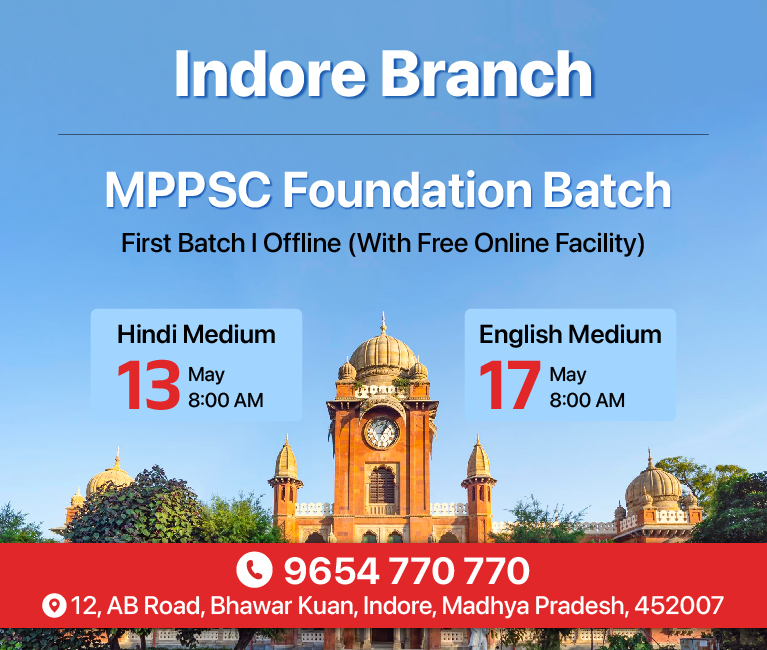
Social Justice
Gender Gap in Indian STEM Faculties
For Prelims: STEM, Women in STEMM (WiS) Program, Vigyan Jyoti, International Day of Women and Girls in Science
For Mains: Underrepresentation of Women in Indian STEM, Policy Formulation about STEM Sciences, Education
Why in News?
A significant gender gap exists in Indian STEM(science, technology, engineering, and math) faculties, with a BiasWatchIndia study revealing that only 13.5% of faculty members across 98 universities and institutes are women.
- This underrepresentation is more prominent in India compared to countries like the US and UK.
Why is there a Gender Gap in Indian STEM Faculties?
- Social Bias Against Women in Certain STEM Fields: Fields like Biology, seen as "soft sciences," have higher female representation compared to hard sciences like Engineering and Physics.
- Societal biases discourage women from pursuing fields perceived as less feminine, affecting their choices in higher education and research.
- Lack of Support During PostDoc to Faculty Transition: The critical transition from postdoc to faculty often aligns with family planning, leading to difficult choices for women.
- Societal pressure prioritising family over career ambitions and a lack of support structures exacerbate the challenge.
- Toxic Workplace Environment: Many women exit STEM academia due to a toxic work environment.
- Factors include disrespect, inadequate access to resources, and limited advancement opportunities compared to male colleagues.
- Difficulty Accessing Gender Representation Data: Absence of a central database tracking women faculty in STEM across India.
- Lack of data hinders understanding of the gender gap and monitoring progress towards gender equality.
What are the Government Initiatives to Promote Women in STEM?
- Women in STEMM (WiS) Program: Launched by the Department of Science and Technology(DST), it provides scholarships, fellowships, and research grants to women in STEM. It also offers mentorship and networking opportunities.
- Vigyan Jyoti: It was introduced in 2019-20 to encourage meritorious girl students in classes 9-12 to pursue higher education and careers in STEM fields, addressing the underrepresentation of women in these areas.
- Developed by the Department of Science and Technology, it offers workshops, mentoring, and resources for young women in STEM.
- The program provides support from the school level to PhD level.
- Women in Science and Engineering-KIRAN (WISE-KIRAN): It encourages women scientists to pursue research in frontier areas of science and engineering and to address societal problems through S&T-based internship and self-employment opportunities.
- Many well-qualified women face challenges in participating in S&T activities due to circumstances typically associated with gender, such as career breaks due to motherhood and family responsibilities.
- To address these issues, the DST will provide opportunities for women scientists and technologists aged 27-57 who have taken a career break but wish to return to mainstream work.
What Steps can be Taken to Bridge the Gender Gap in Indian STEM Faculties?
- Flexible Work Arrangements and On-site Childcare: Offer flexible work schedules, part-time options, and on-site childcare facilities for female faculty members, particularly those with young children. This can help address work-life balance challenges.
- Programs like DST's WISE-KIRAN can be expanded to offer targeted support, such as childcare options and flexible work arrangements, to ease this crucial transition.
- "Back to Academia" Fellowships: Creating fellowship programs that support women who may have taken a break from academia to raise families, providing them with resources and mentorship to re-enter the research and teaching track.
- International Collaboration and Exchange Programs: Encouraging female faculty members to participate in international research collaborations and exchange programs, broadening their perspectives and research networks.
- Visibility and Recognition: Highlighting and celebrating the achievements of female faculty members through awards, public recognition, and media coverage. This boosts morale, inspires others, and promotes role models.
- Women Safety and Data-Led Development: Robust policies are needed in addressing workplace harassment and ensuring equal opportunities are crucial for retaining female talent.
- Data collection on female faculty can be incorporated to create a central database, enabling better-targeted interventions.
|
Drishti Mains Question: Q. Analyse the factors contributing to the underrepresentation of women in Indian STEM and evaluate the effectiveness of existing initiatives related to promoting women in STEM. |
UPSC Civil Services Examination, Previous Year Question (PYQ)
Mains
Q.1 “Empowering women is the key to control population growth”. Discuss. (2019)
Q.2 Discuss the positive and negative effects of globalisation on women in India? (2015)
Q.3 Male membership needs to be encouraged in order to make women’s organisations free from gender bias. Comment. (2013)


Governance
Social Media Regulation in India
For Prelims: Supreme Court of India, Social media, Information Technology Act, 2000, Section 69A of the IT Act, 2000, Section 79(1) of the IT Act, 2000, Information Technology (Intermediary Guidelines and Digital Media Ethics Code) Rules, 2021, LGBTQIA+
For Mains: Regulation of Social Media in India, Impacts of Social Media on Different Sections of Society.
Why in News?
Recently, the Supreme Court of India has raised concerns about the growing misuse of social media to spread misinformation about ongoing court cases. The court believes this "fake news" interferes with judicial proceedings and needs to be addressed.
How Social Media is Regulated in India?
- Information Technology Act, 2000 (IT Act): It is the principal law that by establishing a legal foundation for electronic governance and governs all areas of electronic communication, including social media
- Section 69A of the IT Act, 2000 empowers Government to block information from public access under specific conditions of
- interest of sovereignty and integrity of India
- defence of India
- security of the State
- friendly relations with foreign States
- public order
- for preventing incitement to the commission of any cognizable offense relating to above.
- Section 79(1) of the IT Act, 2000 grants intermediaries (like social media platforms) exemption from liability for third-party information, subject to certain conditions:
- The intermediary's role is limited to providing access to a communication system through which third-party information is transmitted, hosted, or stored.
- The intermediary does not initiate or control the transmission, recipient selection, or content modification.
- However, some controversial sections like Section 66A (dealing with online content) were struck down by the Supreme Court due to concerns about freedom of speech in Shreya Singhal V/s Union of India Case.
- Section 69A of the IT Act, 2000 empowers Government to block information from public access under specific conditions of
- Information Technology (Intermediary Guidelines and Digital Media Ethics Code) Rules, 2021: The IT Rules (2021) mandate social media platforms to exercise greater diligence in content moderation, ensuring online safety by promptly removing inappropriate content.
- Users must be educated about privacy policies, avoiding copyrighted material, defamatory content, or anything that threatens national security or friendly relations.
- The 2023 Amendment to these rules states that online intermediaries, including social media platforms like Facebook and internet service providers like Airtel, must prevent the spread of inaccurate information about the Indian government.
- They should also remove content flagged as false by fact-checking units to maintain legal protection from third-party content.
- However, the implementation of amended provisions was recently halted by the Supreme Court.
What are the Impacts of Social Media on Different Sections of Society?
- Youth and Students:
- Pros: Access to information, educational resources, networking opportunities, and platforms for self-expression and activism.
- Cons: Risk of cyberbullying, distraction from studies, mental health issues due to comparison and social pressure.
- Example: Blue whale game.
- Women:
- Pros: Social media provides a platform for women to voice their opinions, share experiences, and advocate for gender equality, women's rights, and social issues.
- Example: Me Too movement
- Cons: Perpetuates unrealistic beauty ideals, leading to body image issues, self-esteem issues, harassment leading to cyberbullying and mental health concerns.
- Pros: Social media provides a platform for women to voice their opinions, share experiences, and advocate for gender equality, women's rights, and social issues.
- LGBTQIA+:
- Pros: Social media empowers LGBTQIA individuals by providing visibility, advocacy platforms, education, and community networking.
- Cons: However, it also exposes them to cyberbullying, privacy risks and stigmatisation.
- Businesses and Entrepreneurs:
- Pros: Cost-effective marketing, customer engagement, brand promotion, and access to a global market.
- Cons: Negative feedback and public relations crises can spread rapidly, competition from online platforms, dependence on algorithms for visibility.
- Government and Politics:
- Pros: Enhanced communication with citizens, transparency, mobilization of support for policies and campaigns.
- Cons: Spread of misinformation, polarisation, privacy concerns, potential for foreign interference in elections.
- Example: Cambridge Analytica Scandal.
- Judiciary:
- Pros: Social media can enhance transparency by providing real-time updates on court proceedings, judgments, and legal developments to the public.
- Cons: Risk of misinterpretation or distortion of legal information shared on social platforms, potentially leading to misinformation.
- Media and Journalism:
- Pros: Instant news dissemination, audience engagement, citizen journalism, and diverse perspectives.
- Cons: Fake news and misinformation challenges, loss of traditional revenue models, echo chambers affecting objectivity.
- Elderly and Less Tech-Savvy Individuals:
- Pros: Connectivity with family and friends, access to information and services.
- Cons: Digital divide, susceptibility to online scams and misinformation, privacy concerns due to lack of technical knowledge.
What Measures can be Taken to Improve Utility and Credibility of Social Media?
- Algorithmic Transparency: Requiring platforms to disclose and explain their algorithms' functioning to mitigate biases and improve content visibility.
- Requiring platforms to publish regular transparency reports on content moderation, data practices, and compliance with regulatory standards to enhance accountability.
- Digital Literacy Programs: Implementing comprehensive digital literacy education to empower users in identifying and combating misinformation and online harassment.
- AI Moderation Tools: Developing advanced AI tools for content moderation to swiftly detect and remove harmful content while protecting freedom of expression.
- Privacy-Enhancing Technologies: Investing in technologies such as end-to-end encryption and data anonymisation to bolster user privacy and security.
- Ethical Design Practices: Encouraging ethical design practices that prioritise user well-being, mental health, and meaningful engagement over maximising user attention.
- Rewarding Positive Content Creation: Implementing mechanisms to incentivize users who create informative, educational, or community-building content.
- India’s National Creators Award 2024 is a significant step in this direction.
|
Drishti Mains Question: Discuss the challenges and prospects of regulating social media platforms in India, considering the balance between freedom of expression, privacy concerns, and the need for accountability. |
UPSC Civil Services Examination Previous Year Question:
Q. What are social networking sites and what security implications do these sites present? (2013)
Q. Child cuddling is now being replaced by mobile phones. Discuss its impact on the socialization of children. (2023)


International Relations
UK Passes Bill to Deport Asylum Seekers to Rwanda
For Prelims: United Kingdom, Rwanda, Asylum Seeker, United Nations High Commissioner for Refugees (UNHCR), Refugee, 1951 Refugee Convention, Illegal Migrant
For Mains: Implications of UK Policy on Asylum Seeker, Issue of Migration
Why in News?
Recently, the United Kingdom government has passed a controversial bill to send asylum seekers to Rwanda in an effort to curb the number of asylum seekers crossing the English Channel.
What is the Rwanda Bill?
- About: The Safety of Rwanda (Asylum and Immigration) Bill in the United Kingdom originated from a policy initiated by a former UK Prime Minister in 2022.
- Its main aim is to enable the deportation of undocumented immigrants to Rwanda by designating it as a safe third country.
- Safe third country implies that asylum seekers can be sent to a country other than where they seek asylum or where they belong, if it Is deemed safe.
- However, global consensus on this concept is lacking, leading to apprehensions about its implementation.
- Its main aim is to enable the deportation of undocumented immigrants to Rwanda by designating it as a safe third country.
- U.K.-Rwanda Deal on Refugees: In April 2022, the former UK Prime Minister introduced the Migration and Economic Development Partnership (MEDP), aimed at relocating asylum seekers unrecognised by the UK to Rwanda.
- Under the Memorandum of Understanding (MoU) between the two countries, the UK assesses asylum applications and arranges transportation to Rwanda.
- Rwanda then takes over, providing shelter and protection, with the sole power to grant refugee status, those denied are returned to their home countries.
- Under the Memorandum of Understanding (MoU) between the two countries, the UK assesses asylum applications and arranges transportation to Rwanda.
- Criticism:
- Wider Ramifications: The bill circumvents existing human rights statutes and limits individuals' appeal options.
- It is not an isolated incident, with other European countries exploring similar agreements with third countries for processing asylum seekers.
- Human Rights Concerns: Critics argue that Rwanda does not provide adequate protection for refugees and asylum seekers.
- The country has been criticised for its human rights record like Rwandan genocide 1994, including allegations of political repression and lack of freedom of expression.
- Criticism from the United Nations, Council of Europe's human rights watchdog and various NGOs reflects widespread concern over its impact on human rights and asylum seekers, extending beyond the UK's borders.
- Lack of Safeguards: Critics argue that the bill lacks sufficient safeguards to protect the rights of asylum seekers.
- There are concerns that individuals deported to Rwanda may not have access to fair and effective asylum procedures, leaving them vulnerable to arbitrary detention and deportation.
- Wider Ramifications: The bill circumvents existing human rights statutes and limits individuals' appeal options.
- Refugee Crisis in UK: Despite the dangers, a notable number of refugees and asylum-seekers have perished in 2023 attempting to reach the UK.
- Their decision to undertake these risky journeys is often driven by a mix of economic hardship, political persecution, and worsening impacts of climate change, such as environmental degradation and natural disasters.
- Crossing the English Channel in overcrowded and unsafe boats symbolises their desperation and aspiration for a brighter tomorrow.
What is the Difference Between Asylum Seeker, Refugee, Illegal Migrant?
- Asylum Seeker: According to the United Nations High Commissioner for Refugees (UNHCR), an asylum-seeker is someone who has fled their home country and is seeking protection in another country. Their claim for refugee status has not yet been decided.
- Refugee: The 1951 Refugee Convention defines a refugee as someone who has been forced to flee their country because of a well-founded fear of persecution based on race, religion, nationality, political opinion, or membership in a particular social group.
- The core principle of the 1951 Convention is non-refoulement, which asserts that a refugee should not be returned to a country where they face serious threats to their life or freedom.
- Illegal Migrant: The term "illegal migrant" is not an official legal term, but it generally refers to someone who is present in a country without authorization. This could include someone who entered the country without proper documentation or someone who has overstayed a visa.
What are the Regulations Related to Refugees in India?
- India treats all foreigners whether illegal immigrants, refugees/asylum seekers or those overstaying visa permits under
- Foreigners Act of 1946: Under Section 3, the central government is empowered to detect, detain and deport illegal foreign nationals.
- Passport (Entry into India) Act, 1920: Under Section 5, authorities can remove an illegal foreigner by force under Article 258(1) of the Constitution of India.
- Registration of Foreigners Act of 1939: Under this, there is a mandatory requirement under which all foreign nationals (excluding overseas citizens of India) visiting India on a long-term visa (more than 180 days) are required to register themselves with a Registration Officer within 14 days of arriving in India.
- Citizenship Act, 1955: It provided provisions for renunciation, termination, and deprivation of citizenship.
- Further, Citizenship Amendment Act, 2019 (CAA) seeks to provide citizenship to Hindu, Christian, Jain, Parsi, Sikh, and Buddhist immigrants persecuted in Bangladesh, Pakistan, and Afghanistan.
- Also, a Standard Operating Procedure (SoP) was issued in 2011 by the Central Government and amended in 2019 which has to be followed by law enforcement agencies while dealing with foreign nationals who claim to be refugees.
What are the Reasons for India's Not Signing the 1951 Refugee Convention?
- The 1951 convention defines refugees as those deprived of civil and political rights, excluding economic rights.
- India asserts that Including economic rights in the definition could burden developing nations.
- Adhering to the convention could heighten responsibilities and resource demands for hosting refugees, a concern amplified by India's history of refugee inflows due to regional conflicts and porous borders.
- India's decision not to sign the convention allows it to control its refugee policies, that could otherwise impact its sovereignty and domestic plans.
- Nonetheless, India abides by other international human rights treaties and customary law, showcasing a commendable track record in upholding international legal norms.
Way Forward:
- Comprehensive Immigration Policy Framework: There is a need for a comprehensive global immigration policy framework that addresses various aspects of immigration, including asylum, legal migration, and integration.
- It should balance national security with humanitarian concerns.
- The policy making should be based on empirical evidence and research, rather than on stereotypes or fear mongering.
- Further policy should prioritise the protection of vulnerable groups, including refugees and asylum seekers, and provide them with fair and efficient processes for seeking protection.
- Global Refugee Education Fund: UNESCO can create a dedicated fund to support education initiatives in refugee camps and host countries.
- Education empowers refugees, fosters skills development, and prepares them for future opportunities.
- International Cooperation: Focus should be on international cooperation in managing migration flows, including collaboration with countries of origin and transit to address root causes of migration.
- Integration and Inclusion: The focus should be on the integration and inclusion of migrants into host societies, including access to education, healthcare, and employment opportunities.
- Practices for Inclusion:
- Language Support: Offering language courses helps migrants integrate into the workforce and broader society.
- Recognition of Qualifications: Streamlining the process for recognizing foreign professional qualifications allows migrants to contribute their skills readily.
- Anti-discrimination Initiatives: Strong anti-discrimination laws and educational programs foster a welcoming and inclusive environment.
- Practices for Inclusion:
- Refugee as "Resource": Recognizing refugees as a resource underscores the transformative power of inclusion and collaboration in building stronger, more vibrant communities.
- Related Case Studies:
- Canada: A global leader in immigration, Canada actively seeks skilled workers and refugees. This approach has fueled economic growth and made Canada a global hub for innovation, particularly in technology.
- Singapore: This nation-state thrives on its multicultural population. Migrants contribute significantly to its success in finance, engineering, and medicine. Singapore's embrace of diversity has fostered a dynamic and prosperous society.
- Germany: Germany's "guest worker" program in the 1960s brought in millions of workers, who filled vital labour gaps and contributed significantly to the country's post-war economic boom.
- Related Case Studies:
- Long-Term Sustainable Solutions: Shifting focus towards long-term sustainable solutions, including conflict prevention and resolution, addressing root causes of displacement such as political instability, economic inequality, and environmental degradation.
- Invest in peacebuilding efforts, development assistance, and humanitarian diplomacy to create lasting stability and security for communities affected by displacement
|
Drishti Mains Question: Q. Discuss the challenges faced by asylum seekers, including legal, humanitarian, and societal aspects, and analyze the impact of national policies on their rights and well-being. Critically evaluate the effectiveness of international cooperation in addressing the global refugee crisis. |
UPSC Civil Services Examination, Previous Year Questions (PYQs)
Prelims:
Q. Amnesty International is (2015)
(a) an agency of the United Nations to help refugees of civil wars
(b) a global Human Rights Movement
(c) a non-governmental voluntary organization to help very poor people
(d) an inter-governmental agency to cater to medical emergencies in war-ravaged regions
Ans: (b)
Q. A very big refugee camp called Dadaab, recently in the news, is located in (2009)
(a) Ethiopia
(b) Kenya
(c) Somalia
(d) Sudan
Ans: (b)
Mains:
Q. How does illegal transborder migration pose a threat to India’s security? Discuss the strategies to curb this, bringing out the factors which give impetus to such migration. (2014)

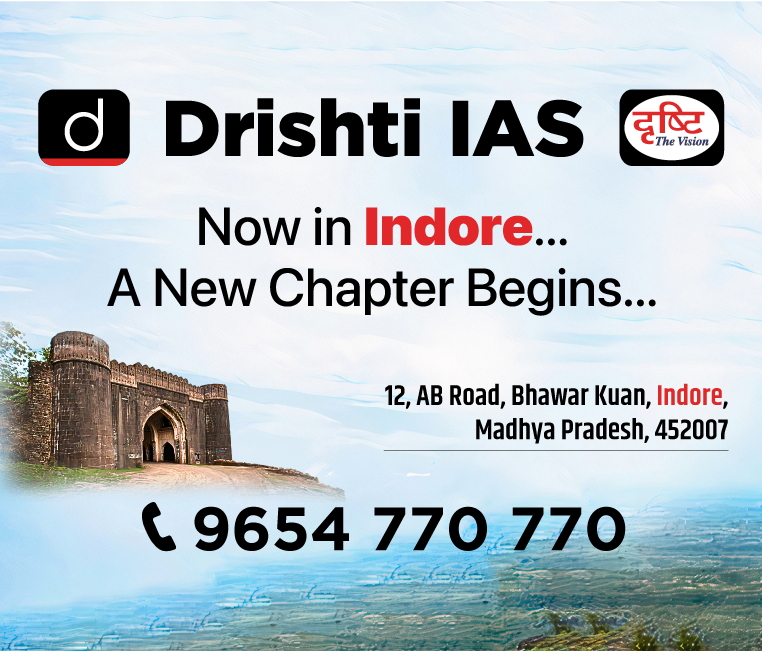
Important Facts For Prelims
Constitutional Promise of Autonomy: Article 244(A)
Why in News?
Recently, in Assam's predominantly tribal Diphu Lok Sabha constituency, candidates from all political parties have pledged to implement Article 244(A) of the Constitution, aiming to establish an autonomous 'state within a state.'
- The demand for autonomy in the region dates back to the 1950s movement for a separate hill state.
- Despite the creation of Meghalaya in 1972, leaders of the Karbi Anglong region opted to remain with Assam, hoping for autonomy through Article 244(A).
What is Article 244(A) of the Indian Constitution?
- Article 244 in Part X of the Constitution envisages a special system of administration for certain areas designated as ‘scheduled areas’ and ‘tribal areas’.
- Article 244(A) was added to the Constitution through the Twenty-second Amendment Act in 1969.
- It allows Parliament to enact a law to establish an autonomous state within the State of Assam comprising all or some of the tribal areas specified in the Sixth Schedule.
What is the Sixth Schedule of the Indian Constitution?
- About: Sixth Schedule covers provisions relating to the administration of tribal areas in the states of Assam, Meghalaya, Tripura and Mizoram.
- Autonomous Districts: Tribal areas in Assam, Meghalaya, Tripura, and Mizoram are governed as autonomous districts but remain under the state's executive authority.
- The governor holds the power to reorganize these districts, including adjusting their boundaries, names, and even dividing them into multiple autonomous regions if there are diverse tribal populations.
- Acts of Parliament or state legislature might not apply directly to these districts unless adapted with specified modifications.
- Autonomous District Councils: Each autonomous district has a district council consisting of 30 members, with 4 nominated by the governor and the remaining 26 elected through adult franchise for a standard term of 5 years, unless dissolved earlier.
- They can make laws on certain specified matters like land, forests, canal water, shifting cultivation, village administration, the inheritance of property, marriage and divorce, social customs and so on.
- But all such laws require the assent of the Governor.
- They can constitute village councils or courts for trial of suits and cases between the tribes. They hear appeals from them.
- The jurisdiction of the high court over these suits and cases is specified by the governor.
- The governor also has the authority to appoint commissions to review district administration matters and can dissolve councils based on their recommendations.
- They can make laws on certain specified matters like land, forests, canal water, shifting cultivation, village administration, the inheritance of property, marriage and divorce, social customs and so on.
What are the Other Demands For Autonomy in India?
- Gorkhaland: The Gorkha-majority areas of Darjeeling and nearby regions in West Bengal have seen demands for a separate state of Gorkhaland due to cultural and historical reasons.
- Bodoland: In Assam, the Bodo-majority areas have witnessed movements for a separate state of Bodoland, citing issues of ethnic identity and socio-economic development.
- Vidarbha: The region of Vidarbha in Maharashtra has seen periodic demands for statehood, citing issues of regional underdevelopment and neglect by the state government.
- Bundelkhand: Parts of Uttar Pradesh and Madhya Pradesh comprising the Bundelkhand region have witnessed demands for a separate state due to perceived economic backwardness and neglect by state governments.
UPSC Civil Services Examination, Previous Year Questions (PYQs)
Prelims
Q. Which of the following provisions of the Constitution of India have a bearing on Education? (2012)
- Directive Principles of State Policy
- Rural and Urban Local Bodies
- Fifth Schedule
- Sixth Schedule
- Seventh Schedule
Select the correct answer using the codes given below:
(a) 1 and 2 only
(b) 3, 4 and 5 only
(c) 1, 2 and 5 only
(d) 1, 2, 3, 4 and 5
Ans: (d)
Mains
Q. Why are the tribals in India referred to as ‘the Scheduled Tribes? Indicate the major provisions enshrined in the Constitution of India for their upliftment. (2016)

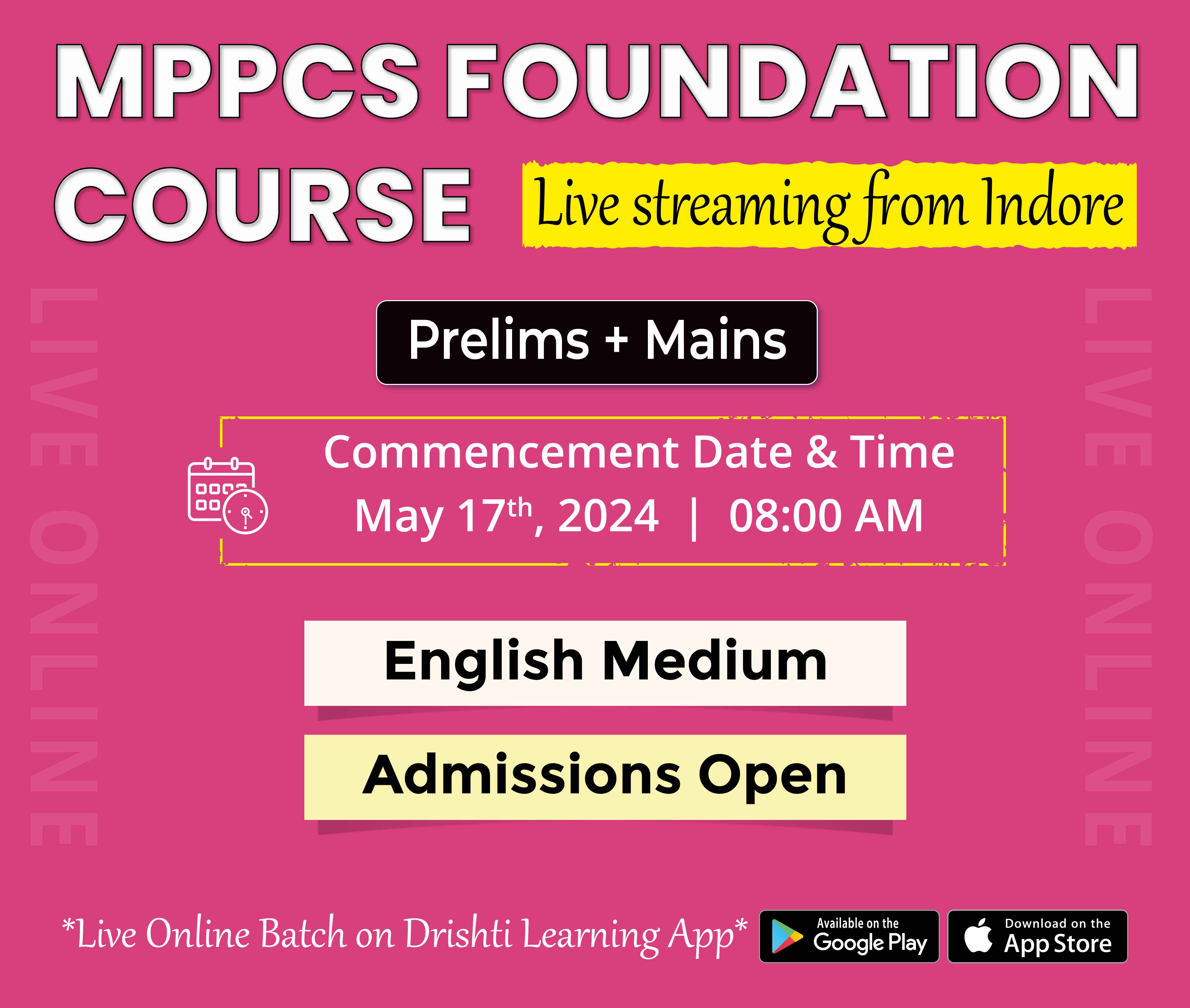
Important Facts For Prelims
Inflammatory Bowel Disease (IBD)
Why in News?
Recently, Inflammatory Bowel Disease (IBD) comprising primarily Ulcerative Colitis and Crohn’s Disease has been on the rise globally.
What is Inflammatory Bowel Disease (IBD)?
- About: IBD is an umbrella term for chronic inflammatory conditions affecting the gastrointestinal (GI) tract.
- Two main forms of IBD:
- Crohn's disease: It can affect any part of the digestive tract, from mouth to anus. Inflammation can be patchy, meaning areas of healthy tissue can be interspersed with inflamed areas. It often affects the deeper layers of the bowel wall.
- Ulcerative colitis: Limited to the inner lining (mucosa) of the large intestine (colon) and rectum. The inflammation is continuous, affecting the entire colon in severe cases.
- Two main forms of IBD:
- Causes: The exact cause of IBD remains unknown, but research suggests a complex interplay of factors like genetics, immune system and environmental factors.
- Symptoms: Abdominal pain and cramping, diarrhea, often bloody, urgent need to have a bowel movement, weight loss and fatigue.
- Treatment: There is no cure for IBD, but treatments aim to manage symptoms and induce remission. These include medications, dietary modifications and surgeries.
- Challenges in India:
- The incidence of IBD has almost doubled in India from 1990 to 2019, underscoring an urgent need for early detection to facilitate better treatment outcomes.
- Diagnosing IBD in India presents unique challenges, especially in distinguishing between Crohn’s Disease and intestinal tuberculosis due to similar clinical symptoms.
- Lifestyle changes, including a shift towards a Westernized diet, are cited as contributing factors to the rising incidence of IBD in India.
Note
IBD is a chronic inflammatory disease of the digestive tract influenced by genetic, immune, and environmental factors, whereas Irritable Bowel Syndrome (IBS) is a non-inflammatory functional bowel disorder possibly linked to altered gut-brain interactions, heightened gut nerve sensitivity, or digestive muscle contraction issues.
UPSC Civil Services Examination, Previous Year Questions (PYQs)
Prelims:
Q. Which one of the following statements best describes the role of B cells and T cells in the human body? (2022)
(a) They protect the body from environmental allergens.
(b) They alleviate the body’s pain and inflammation.
(c) They act as immunosuppressants in the body.
(d) They protect the body from diseases caused by pathogens.
Ans: (d)
Q. In the context of hereditary diseases, consider the following statements: (2021)
- Passing on mitochondrial diseases from parent to child can be prevented by mitochondrial replacement therapy either before or after in vitro fertilization of the egg.
- A child inherits mitochondrial diseases entirely from mother and not from father.
Which of the statements given above is/are correct?
(a) 1 only
(b) 2 only
(c) Both 1 and 2
(d) Neither 1 nor 2
Ans: (c )


Rapid Fire
C-CAMP Joins BFI-Biome Virtual Network Program
The Centre for Cellular and Molecular Platforms (C-CAMP) partners with the Blockchain for Impact (BFI) Biome Virtual Network Program to advance healthcare solutions via biomedical innovation.
- The BFI-Biome Virtual Network Programme is an initiative to bring research institutes and incubators together to foster collaborations.
- Through this programme, BFI will allocate over USD 2,00,000 over three years to develop technologies for accessible and affordable healthcare, leveraging C-CAMP’s expertise.
- The C-CAMP is an initiative of the Department of Biotechnology, Ministry of Science and Technology, with a mandate to be an enabler of cutting-edge life science research and innovation.
- C-CAMP drives biomedical innovations in key areas like infectious disease diagnostics, antimicrobial resistance, cell therapy, immuno-oncology, regenerative tissues, and digital health technologies.
- It also promotes entrepreneurship and innovation through seed funding schemes, mentorship programs, and bio-incubation facilities.
Read More: Synchronising AYUSH and Modern Medicine, Global Initiative on Digital Health


Rapid Fire
Groundwater Recharge Challenges
A recent study estimated groundwater recharge rates in Australia using the Chloride Mass Balance (CMB) method, indicating that climate and vegetation significantly influence recharge rates.
- The CMB is a tracer technique that is used to quantify the recharge rates for groundwater wells in a dry environment using the chloride content of both precipitation and groundwater.
- Researchers state that the groundwater recharge rate is influenced by climate and vegetation factors.
- Climate-related variables include rainfall distribution and evapotranspiration, while vegetation-related factors include the health and density of vegetation.
- Soil properties and geographic variation also influence the rate of groundwater recharge.
- The study emphasised the importance of considering changes in land-use patterns, especially in rapidly urbanising areas, to increase groundwater recharge rates.
- In India’s context, Bengaluru's rapid urbanisation has led to a drastic reduction in green spaces and waterbodies, with built-up areas increasing from 8% in 1973 to 93% in 2020. This has resulted in a severe groundwater crisis, with declining levels each year.
- In India, few studies estimate groundwater recharge rates using CMB, and large-scale analyses of chloride deposition are yet to be attempted.
- The Water Table Fluctuation (WTF) method is common in India, estimating groundwater recharge by monitoring water level changes in wells.
- It is crucial for Indian cities to accurately estimate groundwater recharge rates and explore scientific measurement methods.
Read More: Protecting Our Groundwater: A Priority for a Sustainable Future, Bengaluru's Water Crisis: A Wake-Up Call for India


Place In News
English Channel
Recently, 5 people died trying to cross the English Channel in a small boat on the backdrop of the British parliament passing a controversial law that would permit the deportation of those seeking asylum in the U.K. to Rwanda.
- According to the UK Government, the new law is needed as a deterrent to migrants and smuggling gangs.
English Channel:
- It is an arm of the Atlantic Ocean that separates southern England from northern France.
- It is connected to the southern part of the North Sea through the Strait of Dover at its northeastern tip.
- It is about 560 km long and varies in width from 240 km at its widest to 34 km in the Strait of Dover. It is the busiest shipping area in the world.
- It was a key factor in Britain becoming a naval superpower and has been utilised by Britain as a natural defence mechanism and prevented invasions, such as the Napoleonic Wars and those of Adolf Hitler in World War II.
- The two dominant cultures are English on the north shore of the Channel, and French on the south.
- There is a 50.46-kilometre undersea railway tunnel known as Channel Tunnel.
- It was opened in 1994 and connects Folkestone ( England) with Coquelles (France) beneath the English Channel at the Strait of Dover.
Read more: UK’s North Sea Drilling


Rapid Fire
Gold-Spewing Volcano of Antarctica
Recently a study found out that Mount Erebus, in Antarctica, expels pockets of gas containing roughly 80 grams of crystallised gold daily, worth about USD 6,000.
- Mount Erebus and Deception Island are the only two active volcanoes out of a total of 138, present in Antarctica.
- The wind carries this glittering treasure for hundreds of miles, with traces detected as far as 621 miles away.
- It's been in a constant state of eruption since at least 1972, a fiery anomaly amidst the frozen continent.
- Mount Erebus exhibits a particular eruptive style known as Strombolian eruptions. These eruptions are characterised by moderate intensity, with bursts of gas and ash shooting skyward.
- Mount Erebus hosts a lava lake at its summit crater which is a rare phenomenon. This molten rock pool remains unfrozen at the surface due to specific conditions within the volcano.
Read more: India’s New Post Office in Antarctica



